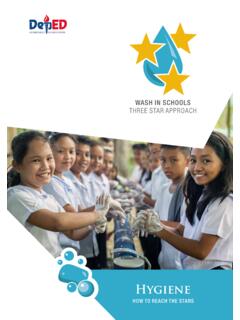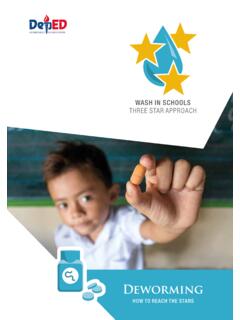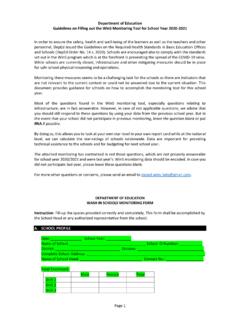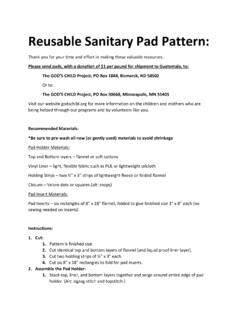Transcription of MENSTRUAL HYGIENE MANAGEMENT - Department of …
1 MENSTRUAL HYGIENE MANAGEMENT WinS MONITORING RESULTS PHILIPPINES // SCHOOL YEAR 2017/2018 TO 2019/2020 WATER SANITATION HYGIENE HEALTH EDUCATIONBACKGROUNDM enstrual HYGIENE MANAGEMENT (MHM) is defined by the Joint Monitoring Programme (JMP) of WHO and UNICEF as: Women and adolescent girls use hygienic materials to absorb or collect MENSTRUAL blood, which can be changed in privacy as often as necessary for the duration of a MENSTRUAL period, use soap and water for washing the body as required, and have access to safe and convenient materials to dispose of used materials.
2 They understand the basic facts linked to the MENSTRUAL cycle and how to manage it with dignity and without discomfort or fear. Water, sanitation, and HYGIENE (WASH) is crucial in ensuring appropriate MENSTRUAL HYGIENE MANAGEMENT among girls. It is, thus, important to improve WASH services in Schools to ensure that menstruation will not get in the way of education. In the Philippines, the Department of Education (DepEd) issued the National WinS Policy (DepEd Order 10, Series 2016). DepEd conducts annual monitoring to track progress of schools implementing the WinS policy.
3 The baseline monitoring was conducted in School Year (SY) 2017/18, with about 30 000 schools participating. The second round of WinS monitoring was conducted in SY 2018/19, with about 35,000 schools latest round of monitoring was conducted in School Year 2019/2020, with a total of 39,814 participating schools or approximately 88% of public schools in the country. This report shows the MHM-related data within the WinS monitoring and presents the impressive improvements which schools all over the country have achieved within the last years. KEY INSIGHTSM onitoring data for the school year (SY) 2019/20 show that availability of water in schools continues to increase.
4 A considerable number of schools, however, still do not have access to water. More than a quarter of the schools WinS MONITORING MHM WATER AVAILABILITY TABLE 1. WATER AVAILABILITYS chool Year 2017/2018 School Year 2018/2019 School Year 2019/2020 Elementary SchoolsSecondary SchoolsElementary SchoolsSecondary SchoolsElementary SchoolsSecondary SchoolsTotal no. of schools 25,6404,94628,9146,09132,6197,195 Availability of water in % % % % % % only certain days of the % % % % % % only certain hours in a % % % % % % all school % % % % % %CONTINUOUS IMPROVEMENTS ARE SEEN FROM THE DATA IN 2017/18 UP TO THE LATEST MONITORING DATA IN 2019/20 All indicators on MHM have improved in the SY 2019/20.
5 The improvements seen in the latest monitoring results highlight the use of monitoring to guide the schools and allow them to check which aspects need to be improved. There are areas, however, that still need more attention, particularly the availability of IEC materials for both students and teachers, availability of water at all school hours, and infrastructure-related indicators such as the availability of washing facilities inside the toilets and the number of toilets to reduce the number of girls sharing the OF EXISTING RESOURCES KEY IN SUSTAINING IMPROVEMENTSMany indicators for MHM can be easily improved using existing resources at school level.
6 The availability of rest space for girls with MENSTRUAL discomfort is one indicator which doesn t need big investment from the school, but only use of existing space within school grounds. Likewise, provision of locks, wrapping materials, and trash bins and distribution of existing IEC materials are indicators that do not require big investments and can be complied with using existing resources but can substantially improve MHM in schools and make an important change for girls to manage their menstruation in schools. NEED TO INVEST MORE ON INFRASTRUCTURE -RELATED INDICATORS Despite the improvements seen over the past three years, the average number of students per functional toilet for female is still high and doesn t meet the national standard of 1:50 toilet-pupil ratio.
7 Proximity of toilet to classrooms and the availability of washing facility inside female toilet is also still lacking in a considerable number of schools, with 17,973 ( ) elementary schools and 2,180 ( ) secondary schools still without washing facility inside toilets. These indicators are important areas that will need more investment to further support girls in MENSTRUAL HYGIENE MANAGEMENT while at still lack water at all school hours. Access to water, ideally at all school hours, is necessary in ensuring appropriate MENSTRUAL HYGIENE MANAGEMENT . The latest monitoring data show that there are more toilets accessible to students in SY 2019/20, hence less girls are sharing toilets.
8 This is an improvement from the previous monitoring data from SY 2018/19 which still showed a higher toilet to pupil ratio indicating that previously more girls had to share a facility. Continuous improvement in terms of the quality of facilities can also be seen, as shown by the availability of toilets with locks, lighting, and adequate ventilation. There is also a continuous increase in the availability of toilets with wrapping materials and trash bins for used pads. While there was a decrease in the availability of washing facility inside the toilet from baseline (SY 2017/18) to follow-up (SY 2018/19), latest monitoring results show a slight increase compared to the last SY.
9 Having a washing facility inside female toilets is important to allow girls to better manage MENSTRUAL HYGIENE while in schools. The water outlet to student ratio likewise continues to improve, with more schools having one facility shared by less than 50 students. While there is a decrease in the number of schools with no handwashing facility, 4,404 elementary schools and 849 secondary schools still lack handwashing facility inside school grounds. Availability of rest space for girls with MENSTRUAL discomfort, on the other hand, was shown to have continuous increase.
10 This indicates the feasibility of using existing resources to comply with the DepEd 2. MHM-FRIENDLYSANITATION FACILITIESS chool Year 2017/2018 School Year 2018/2019 School Year 2019/2020 Elementary SchoolsSecondary SchoolsElementary SchoolsSecondary SchoolsElementary SchoolsSecondary SchoolsTotal no. of schools 25,6404,94628,9146,09132,6197,195 Average number of students per functional toilet for of schools where all functional toilets are secure, private and have door with lock % % % % % % all functional toilets have lighting % % % % % % all functional toilets have adequate ventilation % % % % % %All exclusively female toilets have wrapping materials and trash bins for used sanitary pads % % % % % %Exclusively female toilets have a washing facility inside the toilet % % % % % %Detached toilets for girls within view of school building and people % % % % % %Water-outlet to student ratio less than 1 % % % % % % 1 % % % % % %



